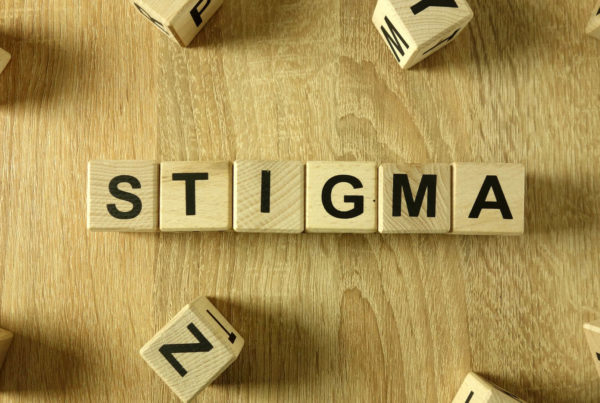It has been well documented that the stigma associated with mental illness has an impact on an individual’s ability and willingness to seek treatment for mental health related issues. Despite various forms of mental illness being quite prevalent in the United States (for example, depression affects 1 in 8 people), the majority of folks with mental health problems end up not receiving treatment partially due to this phenomenon.
But what about the people who do seek help? Can issues related to stigma have an impact on the success of their mental health treatment?
Before we can answer these questions, we first have to examine what we in the mental health field mean when we refer to “stigma.” Stigma has often been described in two ways:
- public stigma, which generally revolves around the public’s negative view of mental illness;
- and self-stigma, which is when these public views become internalized, so that the individual themselves begin to have a negative perception of their own mental illness, as well as a negative perception of the concept of seeking help for their problems.
These two types of stigma are related, but studies show it is the self-stigma that has a greater impact on individuals and their treatment. Furthermore, when breaking down the variables of self-stigma, it has become known that the person’s negative views of the idea of seeking help are even more of a barrier to successful treatment than their negative views of mental illness. (Interestingly, there is also a gender gap and an ethnicity gap in self-stigma; higher levels of self-stigma are seen in men and in people of color.)
Self-stigma creates a number of problems for individuals suffering from mental illness. First, due to their own negative views of mental illness, they engage in derogatory self-talk about their symptoms and end up only feeling worse about themselves. Secondly, the self-stigma may also have them believing that anyone who reaches out for help is “lazy, dim-witted, and weak.” They may feel this way even when encouraged to seek help by their loved ones, co-workers, or others. When and if they finally do seek treatment, they often drop out before the treatment interventions have any chance for success, which only serves to perpetuate the self-stigma by having the person believe the treatment is not helpful anyway, and they should be able to handle their problems themselves. The end result here can be disastrous: They don’t get the treatment, or they don’t stay in treatment, and they do not perceive the treatment as helpful – all terribly negative outcomes. In other words, the person who is suffering the most and needs the help desperately in the end becomes someone who actively rejects that help.
So how do we go after the stigma?
Attacking Stigma with Knowledge
The kryptonite of mental health stigma is mental health literacy. Data suggests that the more the public knows about mental health issues, diagnoses, and treatments, the less likely they are to develop a high degree of stigma related to mental illness. Certainly any decrease we have seen in stigma related to mental illness in recent years has come about as a result of effective education to the public at large regarding mental illness and successful treatments. This is a good thing that has occurred mostly through “macro” targeting efforts in public outreach and education, through various media outlets and other means. By reducing public stigma in this way, these efforts indirectly influence self-stigma as less negative public views are internalized. By all means, these successful macro-targeting efforts should continue.
However, new data suggests we need to supplement these public efforts with “micro” educational efforts targeted at the individuals themselves who are contemplating asking for help or who are in the early phases of their mental health treatment. This can be accomplished in a number of ways:
- Primary Care Providers (PCPs) are presented with clients on a daily basis who are struggling with mental health issues, even if that is not the stated reason of their medical visit. PCPs need to be willing to inquire about mental health-related issues; they also should educate their clients about how common these struggles are and let them know there are effective treatments available.
- Many PCPs can prescribe appropriate medication, but PCPs generally do not provide ongoing therapy for their clients; these clients, therefore, should be referred out for therapy.
- Educating the client on the medical model of psychiatric disorders such as depression, anxiety and addiction (that is to say, these disorders are really no different from hypertension, diabetes, and heart disease), along with normalizing the need for therapy with an emphasis on how effective therapy can be, would go a long way in decreasing self-stigma.
- Employee Assistance Programs (EAPs) are utilized by many employers as a way to educate and support their workers who may be struggling with emotional issues. EAPs also facilitate the process of seeking and retaining help in the community.
- For youth, school-based mental health access has greatly diminished the self-stigma in young people, as getting help for their problems seems more like a normal part of their school day than going offsite to see a counselor.
Efforts like these can directly target self-stigma and have resulted in more people pursuing mental health treatment – but even after the person has finally made it to treatment, the battle against self-stigma is still not over.
The provider must continue to micro-target his or her efforts to their client to continue to educate them around mental disorders and also support their brave move to seek help. Remember that it is the negative view of seeking help that is the most powerful negative determinant to successful treatment. Providers should not shy away from directly addressing the client’s attitude toward seeking treatment very early on: How do they feel about seeking treatment? What would help alleviate any negative feelings?
In addition, the provider should also initially assess the client’s goals for their treatment – in other words, what will determine if the treatment is resulting in improvement and eventual success? If possible, the goal should be achievable and measurable. For example, a depressed client may say their mood is a “2” on a 10 point scale. Help the client delineate their goal – would it be to reach “7,” or maybe “8?” Only by setting realistic and measurable goals can the client and the provider know if treatment is actually progressing and eventually if treatment has been successful. If the client begins to believe the treatment is not successful, they are much more likely to drop out.
Frequently checking with the client on their goals is essential. Sometimes clients are improving and do not even realize they are! Even if the client is “not feeling it,” sometimes asking about how others in their life have perceived them lately can be very beneficial. You may hear something like: “I still feel about the same, but now that you mention it my wife did say I seem less grumpy and irritable lately!” The perception of positive change in treatment has been shown to be directly related to decreasing self-stigma, which will result in improved outcomes.
Self-stigma results in poor mental health outcomes. Improving mental health literacy through micro-targeting individual clients to improve knowledge about mental health related issues while decreasing negative stereotypes around seeking help, will go a long way to improving these outcomes.






